Are you ready to take your fishing game to the next level? One of the essential skills every angler needs to master is stringing a fishing pole.
Whether you’re a total newbie or just need a refresher, this step-by-step guide will walk you through the process and have you casting like a pro in no time.
Table of Contents
Gathering Your Supplies for Stringing a Fishing Pole
Before you begin stringing your fishing pole, it’s essential to gather all the necessary supplies. You’ll need a fishing rod, fishing line, scissors, and your preferred fishing reel.
Make sure you have the correct fishing line weight and type for the fish you plan to catch. For beginners, a monofilament line is a great choice due to its versatility and ease of use.
Step 1: Thread the Line Through the Guides
The first step in stringing your fishing pole is threading the fishing line through the rod’s guides. Start by feeding the line through the largest guide located closest to the reel.
Then, continue threading the line through each subsequent guide, working your way towards the tip of the rod. Make sure the line is correctly seated in each guide to prevent tangling during casting.
Step 2: Attaching the Line to the Reel
With the line threaded through the guides, it’s time to attach it to the reel. Open the bail of the reel and carefully tie the line to the spool using an arbor knot or your preferred knot for securing the line to the reel.
Double-check that the knot is secure to avoid any mishaps while reeling in your catch.
Step 3: Spooling the Line
Once the line is securely attached to the reel, it’s time to spool the line. Hold the line taut with one hand and begin reeling in the line with the other.
Make sure the line is spooled evenly onto the reel to prevent tangles and snags during casting. Keep an eye on the line to ensure it is spooling smoothly and without any twists.
Step 4: Tension and Tighten
As you spool the line, apply slight tension with your free hand to ensure the line is winding neatly onto the reel. This will help prevent loose loops and tangles that can affect your casting distance and accuracy.
Once the line is fully spooled, trim any excess line, leaving a few inches for attaching your preferred fishing lure or bait.

Step 5: Selecting the Right Setup
Now that your fishing pole is strung and ready to go, it’s essential to select the right setup for the type of fishing you plan to do.
Consider the water conditions, target fish species, and your preferred fishing style when choosing your bait, lures, and other tackle. By matching your setup to the fishing conditions, you’ll increase your chances of a successful day on the water.
Step 6: Practice Your Cast
Use your fishing pole properly to string and your setup is ready to go, it’s time to practice your casting technique. Head to an open area, such as a park or open field, and practice your casting motion.
Focus on smooth, fluid movements, and pay attention to the timing of your release to achieve a smooth, accurate cast.
Final Tips for Beginners
As a beginner, there are a few additional tips to keep in mind as you practice your newfound skill of stringing a fishing pole:
- Check Your Equipment: Before every fishing trip, inspect your rod, reel, and line for any signs of wear or damage. Replace any worn components to prevent equipment failure while fishing.
- Learn Proper Knot Tying: Master a few essential knots for attaching your line to the reel, tying on lures, and securing your line to swivels or leaders. A secure knot is vital for landing that trophy fish.
- Practice Patience: Fishing requires patience, so take the time to learn and enjoy the process. Remember, every cast and retrieval is an opportunity to hone your skills and learn from the experience.
- Respect the Environment: As an angler, it’s essential to respect the natural habitats of the fish you pursue. Practice catch-and-release techniques when appropriate, and always follow local fishing regulations and guidelines.
With these steps and tips in mind, you’re well on your way to mastering the art of stringing a fishing pole. Remember, practice makes perfect, so don’t be discouraged by a few tangles or missed casts.
With time and experience, you’ll be casting like a seasoned angler and reeling in the big ones in no time.
Happy Fishing!




